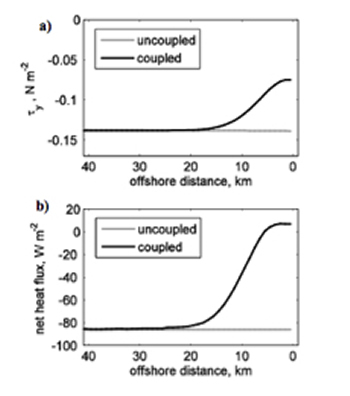Mode water formation and boundary layer dynamics
by Roger Samelson
Roger is interested in the ocean and atmosphere processes that lead to mode water formation (e.g., Dewar et al., 2005) and the coupled boundary layer dynamics of the ocean and atmosphere and its representation in models (e.g., Samelson et al., 2006; Skyllingstad et al., 2006; Chelton et al., accepted; Perlin et al., accepted). Recent high-resolution coupled modeling has shown that air-sea coupling can change surface stress by 50% in 72 hours in coastal regions, through the influence of variable SST on the atmospheric boundary layer (see attached figure, from Perlin et al). He hopes that the working group can stimulate extensions of the work of, for example, Maloney and Chelton (2006), that will focus in more detail on the air-sea interaction processes in the western boundary current and mode water formation regions, and their representation in models, and which will be informed by in-situ measurements as well as remote-sensing data. Important basic questions that he believes are open include:
- How do the ocean and atmosphere boundary layers interact during mode water formation, and what processes must be resolved to model this interaction adequately?
- How does this boundary layer interaction affect larger-scale circulation and variability in the ocean and the atmosphere?
- Do large-scale ocean dynamical or regional air-sea interaction processes dominate mode-water formation, and what is the dependence of their relative influence on timescale?

